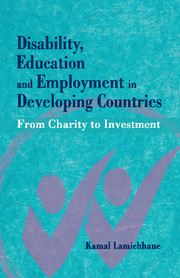Book contents
- Frontmatter
- Contents
- List of Tables and Figures
- Preface
- Acknowledgements
- 1 Fundamentals of Disability Studies
- 2 Disability and the Global Employment Situation
- 3 Disability and the Role of Education in Jobs: Case Studies from Nepal and the Philippines
- 4 Disability and Jobs in a Post-Conflict Country: Cambodia
- 5 Gender and Jobs: A Comparison between People with and without Disabilities in Bangladesh
- 6 Disability and Human Capital Investment
- 7 Disability, Poverty and Inequality: A Case Study in Nepal
- 8 Disability and Job Satisfaction Differentials
- 9 Disability and Determinants of Education: A Case from India
- 10 Disability and Barriers to Education
- 11 The Way Forward: Investment in Disability
- Index
- About the Author
7 - Disability, Poverty and Inequality: A Case Study in Nepal
Published online by Cambridge University Press: 05 February 2015
- Frontmatter
- Contents
- List of Tables and Figures
- Preface
- Acknowledgements
- 1 Fundamentals of Disability Studies
- 2 Disability and the Global Employment Situation
- 3 Disability and the Role of Education in Jobs: Case Studies from Nepal and the Philippines
- 4 Disability and Jobs in a Post-Conflict Country: Cambodia
- 5 Gender and Jobs: A Comparison between People with and without Disabilities in Bangladesh
- 6 Disability and Human Capital Investment
- 7 Disability, Poverty and Inequality: A Case Study in Nepal
- 8 Disability and Job Satisfaction Differentials
- 9 Disability and Determinants of Education: A Case from India
- 10 Disability and Barriers to Education
- 11 The Way Forward: Investment in Disability
- Index
- About the Author
Summary
Introduction
Poverty is a global phenomenon. Irrespective of disability status, there is a significant difference between poverty and all other human conditions. The International Labor Organization (ILO) has stated that poverty and prosperity are two opposite poles which do not go in the same direction: poverty anywhere constitutes a danger to prosperity everywhere (ILO 1944). Poverty creates a huge gap among people living in the same society. Perhaps in recognition that poverty imposes a global threat, the Millennium Development Goals (MDGs), which come to an end formally in 2015, have made it a top priority in improving the quality of life of people across the globe.
As a part of supporting the MDGs, since 1999 the World Bank and the International Monetary Fund have been focusing on the introduction of poverty reduction strategies (PRS) in developing countries. Other international development agencies have also adopted similar strategies to support low-and middle-income countries in their attempts to mitigate poverty.
Despite the efforts of these agencies and their funding targeted to lift people out of extreme poverty based on country-driven needs, there is still a lack of an overall strategy focusing on people with disabilities and their families who are among the largest minority groups vulnerable to poverty. Poverty among people with disabilities remains one of the most challenging global issues. Disability and poverty are highly correlated; while those with disabilities in developing countries remain largely invisible from mainstream society (Graham et al. 2013; Grech 2009; Loeb et al. 2008; Purdam et al. 2008.
It is estimated that people with disabilities make up approximately 15–20 per cent of the poor in developing countries (Elwan 1999). Although there are many different reasons for the incidence of poverty among people with disabilities in developing countries, poor and unequal access to education or employment is likely to be one of the major factors. Oliver (1991) argues that people with disabilities are trapped in a cycle of poverty because of their under-employment and their restriction to poorly paid work.
- Type
- Chapter
- Information
- Disability, Education and Employment in Developing CountriesFrom Charity to Investment, pp. 134 - 171Publisher: Cambridge University PressPrint publication year: 2015



